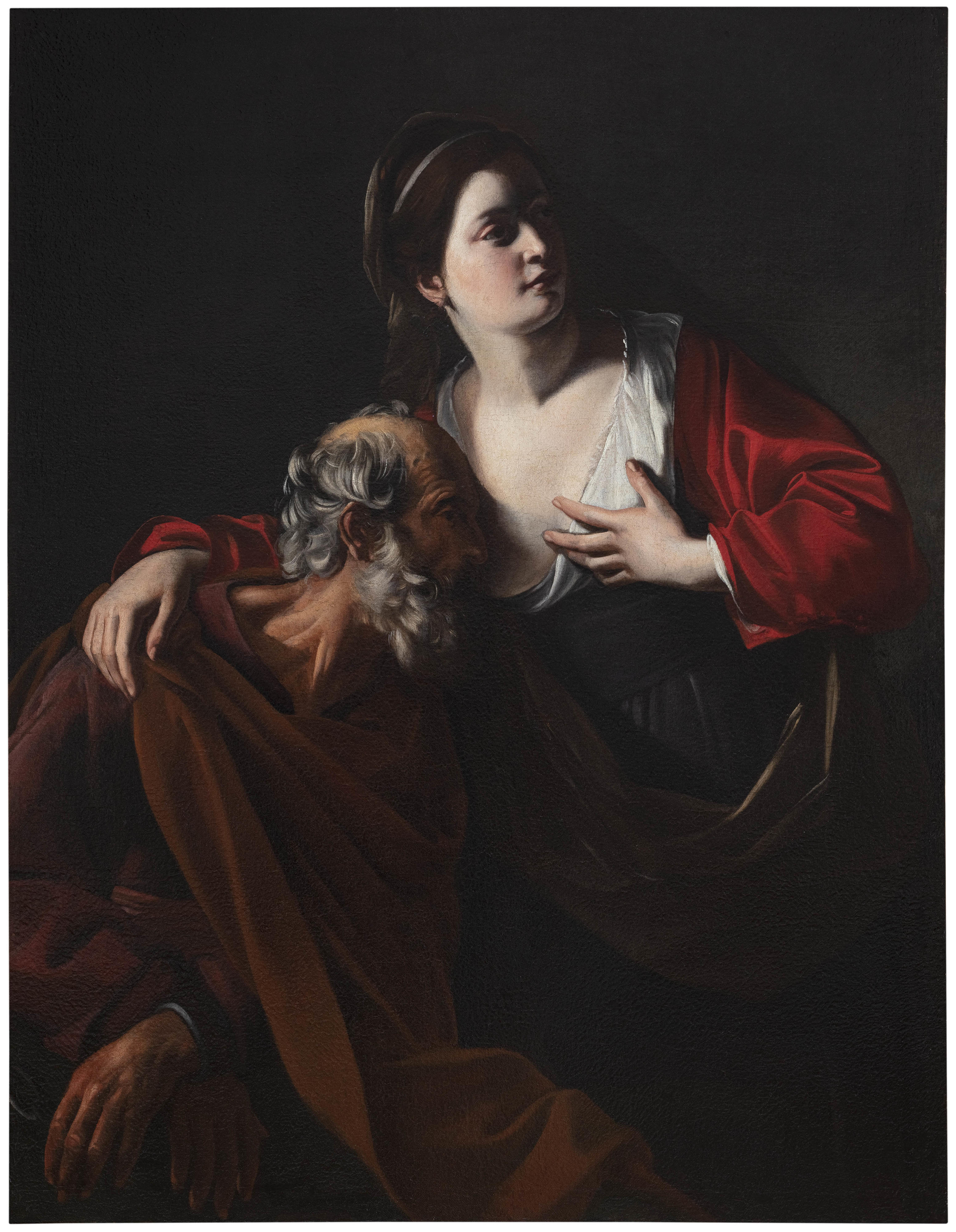Nicolas Tournier
b. 1590, Montbéliard, Franche-Comté
d. 1639, Toulouse
Roman Charity
c. 1620
Oil on canvas
123 x 94 cm (48 3/8 x 37 1/8 in.)
Provenance
Description
In his De Factorum et Dictorum Memorabilium (Memorable Acts and Sayings of the Ancient Romans), the ancient historian Valerius Maximus tells the story of the aged Cimon, imprisoned while awaiting execution and left there to starve until his visiting daughter Pero succored him at her breast. This exemplary tale of filial piety was a particularly popular subject during the seventeenth century in Italy following the example of Caravaggio, who included it in his altarpiece of 1607 for the Pio Monte della Misericordia in Naples depicting the Seven Acts of Mercy (fig. 1). At lower right, the representation of Roman Charity is emblematic of two acts of mercy, namely, feeding the hungry and visiting the imprisoned. Thus, from 1610 onwards, painters enthralled by Caravaggio’s groundbreaking works depicted the subject of Roman Charity again and again. Moreover, many of Caravaggio’s followers came to Italy from other parts of Europe and they took the subject home with them; thus a vogue for gallery pictures representing Roman Charity spread across the continent, taken up by Spanish painters like Ribera and Murillo, Northerners like Rubens, Baburen, Honthorst, and Blomaert, and the French painters Simon Vouet and Valentin de Boulogne. Italian painters too treated the subject, including an impressive nine examples of Roman Charity produced by Caravaggio’s noted foe, Guido Reni.[1]
The present Roman Charity by the French artist Nicolas Tournier was clearly inspired by Bartolomeo Manfredi’s two known treatments of the same subject (fig. 2, Koelliker collection, Milan and fig. 3, Galleria degli Uffizi in Florence), both themselves based on Caravaggio’s influential prototype.[2] While the general arrangement of the two figures in Tournier’s painting is closer to the Uffizi version, as is Pero’s classicising profile and Cimon’s ochre mantle, which takes its cue from that of the Uffizi Pero, the bold red and green costume of Pero in Tournier’s version seems instead to derive from the Koelliker painting.
Tournier was baptised in 1590 in the small town of Montbéliard in the Franche-Comté, where his parents, Protestants from Besançon, had sought refuge. Virtually nothing is known about his early life and training, though it is likely he was initially trained by his father and uncle, who were both painters. It is not known when he left Montbéliard or arrived in Rome, but archival documentation places him in the Eternal City between 1619 and 1626. He then returned to France and is documented in Carcassonne in 1627. From 1632 he was based in Toulouse, but also worked throughout the region, in Carcassonne and Narbonne, for the rest of his career. Together with Nicolas Régnier, Tournier ranks one of the most important French followers of Caravaggio, and an adherent of what the German art historian and painter Joachim von Sandrart dubbed the “Mandrediana Methodus”, whereby individual figures and subjects taken from Caravaggio were mixed and matched, and which effectively used the expressive power of chiaroscuro and the simplification of poses and composition to achieve dramatic intensity. Tournier’s Roman Charity is emblematic of this practice, which sought to meet the demands of an art market desirous of works in the master’s visionary style.
Axel Hémery, the leading scholar on Tournier, endorses the attribution of the present painting, which will be included in his forthcoming catalogue raisonné on the artist. Hémery suggests a date for the work around 1620, thus placing it at the outset of the artist’s Roman period.
[1] For the iconography of Roman Charity, see Jutta Gisela Sperling, Roman Charity: Queer Lactations in Early Modern Visual Culture, Bielefeld, 2016, and Grazia Maria Fachechi, “L’iconografia della Cariatas Romana dal Medioevo a Caravaggio” in Renato Raffaelli, et al., eds., Pietas e allattamento filiale Urbino, 1997, pp. 227–45.
[2] See Gianni Papi, Bartolomeo Manfredi, Soncino, 2013, no. 2, pp. 147–48 (Koelliker) and no. 32, pp. 169–70.
Fig. 1. Caravaggio, Seven Acts of Mercy, 1607, oil on canvas, Pio Monte della Misericordia, Naples.
Fig. 2. Bartolomeo Manfredi, Roman Charity, c. 1610–14, oil on canvas, Koelliker collection, Milan.
Fig. 3. Bartolomeo Manfredi, Roman Charity, c. 1615–17, oil on canvas, Galleria degli Uffizi, Florence.





